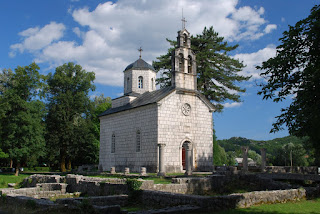The next day we made our way back to the fabulous old town to take in more of its sights. We started by visiting the Rector's Palace which has been turned into a museum showing how the rector used to live. During the Rector's one month term he wasn't allowed to leave the palace without the permission of the senate and so there were rooms containing everything from offices to bedrooms, and even some prison cells in the basement. After the Rector's Palace we made our way to the Maritime Museum which was located in Fort St John, an imposing building built on the edge of the harbour to protect ships. Inside the museum is an extremely detailed description of the maritime industry based in Dubrovnik from the 1st century right up until present day. After visiting the museums we wandered around the picturesque streets some more and visiting a few churches inside the old town before taking a walk around the city walls. The city walls are one of Dubrovnik's most famous sights as they enclose the entire old town and are over 2km long and at some points over 25 meters high, built right over the water. The walk around the walls was absolutely fabulous as it gave some great birds eye views out over the red roofs of the old town and out onto the sea. Definitely a highlight of Dubrovnik. After walking along the walls we returned back to our room to enjoy another home cooked meal.
Our third day in Dubrovnik we spent sea kayaking out to a nearby island about 4km off the coast. The day was beautiful and paddling on the perfectly blue sea was great. We set off from just Northwest of Dubrovnik and quickly left the mainland bay to head for the island. Upon reaching the island we took a short break on the southern point of it where we got to spend a few minutes snorkeling around (there weren't any fish to be seen though) and also some time cliff jumping into a small pool of water. After our break we hopped back in the kayaks to paddle around the island to a small beach complete with a few houses where we left our kayaks and walked for a couple of kilometres to the other side of the island to enjoy lunch. The island was extremely peaceful as there weren't any roads for cars on it and you could tell that everyone there had the relaxed island lifestyle so it was quite enjoyable. After lunch we returned to our kayaks where we enjoyed a short swim before getting back in them and setting out for the mainland again. Once we had crossed the open water we enjoyed a paddle back along the coast passing several caves to our starting point. All said it was a very enjoyable day and the weather was perfect for it. That evening we made our way down to the old town so that we could have a chance to see what the area looked like all lit up at night. Upon arriving there we wandered the streets for a bit and enjoyed a beer while sitting below the clock tower, quite nice.
The next morning we rose nice and early to make our way to the bus station where we quickly boarded a bus bound for Korcula Island, our next destination just a little ways up the coast.

A view from the city walls looking down the main street to the clock tower at the end of it.

A view along the city walls where you can see them towering over the brilliant blue Mediterranean sea.

Standing on the city walls with the red roofs of all the buildings within the old city behind me.

Jumping off the cliff into the small pool of water during our first short break of our kayaking adventure.

Lianne practising her paddling skills while we make our way back towards our starting point during our day out kayaking.

The clock tower lit up at night in the old town.




































